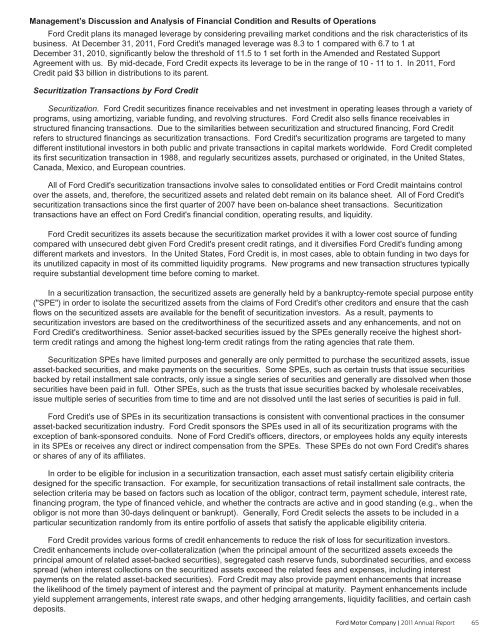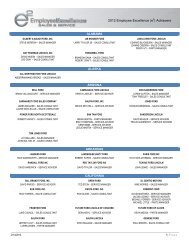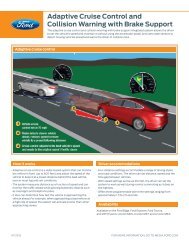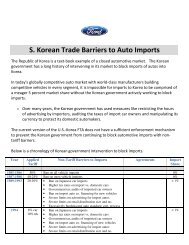Annual Report 2011 - Ford Motor Company
Annual Report 2011 - Ford Motor Company
Annual Report 2011 - Ford Motor Company
Create successful ePaper yourself
Turn your PDF publications into a flip-book with our unique Google optimized e-Paper software.
Management’s Discussion and Analysis of Financial Condition and Results of Operations<br />
<strong>Ford</strong> Credit plans its managed leverage by considering prevailing market conditions and the risk characteristics of its<br />
business. At December 31, <strong>2011</strong>, <strong>Ford</strong> Credit's managed leverage was 8.3 to 1 compared with 6.7 to 1 at<br />
December 31, 2010, significantly below the threshold of 11.5 to 1 set forth in the Amended and Restated Support<br />
Agreement with us. By mid-decade, <strong>Ford</strong> Credit expects its leverage to be in the range of 10 - 11 to 1. In <strong>2011</strong>, <strong>Ford</strong><br />
Credit paid $3 billion in distributions to its parent.<br />
Securitization Transactions by <strong>Ford</strong> Credit<br />
Securitization. <strong>Ford</strong> Credit securitizes finance receivables and net investment in operating leases through a variety of<br />
programs, using amortizing, variable funding, and revolving structures. <strong>Ford</strong> Credit also sells finance receivables in<br />
structured financing transactions. Due to the similarities between securitization and structured financing, <strong>Ford</strong> Credit<br />
refers to structured financings as securitization transactions. <strong>Ford</strong> Credit's securitization programs are targeted to many<br />
different institutional investors in both public and private transactions in capital markets worldwide. <strong>Ford</strong> Credit completed<br />
its first securitization transaction in 1988, and regularly securitizes assets, purchased or originated, in the United States,<br />
Canada, Mexico, and European countries.<br />
All of <strong>Ford</strong> Credit's securitization transactions involve sales to consolidated entities or <strong>Ford</strong> Credit maintains control<br />
over the assets, and, therefore, the securitized assets and related debt remain on its balance sheet. All of <strong>Ford</strong> Credit's<br />
securitization transactions since the first quarter of 2007 have been on-balance sheet transactions. Securitization<br />
transactions have an effect on <strong>Ford</strong> Credit's financial condition, operating results, and liquidity.<br />
<strong>Ford</strong> Credit securitizes its assets because the securitization market provides it with a lower cost source of funding<br />
compared with unsecured debt given <strong>Ford</strong> Credit's present credit ratings, and it diversifies <strong>Ford</strong> Credit's funding among<br />
different markets and investors. In the United States, <strong>Ford</strong> Credit is, in most cases, able to obtain funding in two days for<br />
its unutilized capacity in most of its committed liquidity programs. New programs and new transaction structures typically<br />
require substantial development time before coming to market.<br />
In a securitization transaction, the securitized assets are generally held by a bankruptcy-remote special purpose entity<br />
("SPE") in order to isolate the securitized assets from the claims of <strong>Ford</strong> Credit's other creditors and ensure that the cash<br />
flows on the securitized assets are available for the benefit of securitization investors. As a result, payments to<br />
securitization investors are based on the creditworthiness of the securitized assets and any enhancements, and not on<br />
<strong>Ford</strong> Credit's creditworthiness. Senior asset-backed securities issued by the SPEs generally receive the highest shortterm<br />
credit ratings and among the highest long-term credit ratings from the rating agencies that rate them.<br />
Securitization SPEs have limited purposes and generally are only permitted to purchase the securitized assets, issue<br />
asset-backed securities, and make payments on the securities. Some SPEs, such as certain trusts that issue securities<br />
backed by retail installment sale contracts, only issue a single series of securities and generally are dissolved when those<br />
securities have been paid in full. Other SPEs, such as the trusts that issue securities backed by wholesale receivables,<br />
issue multiple series of securities from time to time and are not dissolved until the last series of securities is paid in full.<br />
<strong>Ford</strong> Credit's use of SPEs in its securitization transactions is consistent with conventional practices in the consumer<br />
asset-backed securitization industry. <strong>Ford</strong> Credit sponsors the SPEs used in all of its securitization programs with the<br />
exception of bank-sponsored conduits. None of <strong>Ford</strong> Credit's officers, directors, or employees holds any equity interests<br />
in its SPEs or receives any direct or indirect compensation from the SPEs. These SPEs do not own <strong>Ford</strong> Credit's shares<br />
or shares of any of its affiliates.<br />
In order to be eligible for inclusion in a securitization transaction, each asset must satisfy certain eligibility criteria<br />
designed for the specific transaction. For example, for securitization transactions of retail installment sale contracts, the<br />
selection criteria may be based on factors such as location of the obligor, contract term, payment schedule, interest rate,<br />
financing program, the type of financed vehicle, and whether the contracts are active and in good standing (e.g., when the<br />
obligor is not more than 30-days delinquent or bankrupt). Generally, <strong>Ford</strong> Credit selects the assets to be included in a<br />
particular securitization randomly from its entire portfolio of assets that satisfy the applicable eligibility criteria.<br />
<strong>Ford</strong> Credit provides various forms of credit enhancements to reduce the risk of loss for securitization investors.<br />
Credit enhancements include over-collateralization (when the principal amount of the securitized assets exceeds the<br />
principal amount of related asset-backed securities), segregated cash reserve funds, subordinated securities, and excess<br />
spread (when interest collections on the securitized assets exceed the related fees and expenses, including interest<br />
payments on the related asset-backed securities). <strong>Ford</strong> Credit may also provide payment enhancements that increase<br />
the likelihood of the timely payment of interest and the payment of principal at maturity. Payment enhancements include<br />
yield supplement arrangements, interest rate swaps, and other hedging arrangements, liquidity facilities, and certain cash<br />
deposits.<br />
<strong>Ford</strong> <strong>Motor</strong> <strong>Company</strong> | <strong>2011</strong> <strong>Annual</strong> <strong>Report</strong> 65









